Topics
Category
Era
Thirty-fourth “Red Bull” Infantry Division
A red steer skull on a black Mexican water jar (olla), created in 1917 while the new division trained at Camp Cody, NM, not far from the Mexican border. During World War II, German soldiers in Italy referred to the Americans who wore the patch as "Red Devils" or "Red Bulls." The latter name stuck, and the division adopted it officially, replacing its World War I nickname of "Sandstorm Division."
The Thirty-fourth “Red Bull” Infantry Division is a U.S. Army National Guard division based in Minnesota. It had more days in combat during World War II than any other American division. Since September 11, 2001, “Red Bulls” have deployed where needed in the world, including Afghanistan and Iraq.
In late summer 1917, not long after the United States entered World War I, the army combined existing National Guard units from Minnesota, Iowa, the Dakotas, and Nebraska to form the Thirty-fourth Infantry Division. The men trained for many months at Camp Cody, near Deming, New Mexico, while waiting anxiously to ship for France. In May, to their disappointment, they were named as a “depot” division. Companies, batteries, and regiments were broken up and the men sent overseas to fill openings in other units. The division was refilled with new draftees and finally departed for France, but by the time it arrived in October, it was too late to see action. The war ended on November 11, 1918.
After World War I, the Thirty-fourth was reorganized with Guardsmen from Iowa, Minnesota, and South Dakota. By summer 1940, fighting again raged in Europe. As a precaution, Congress and President Roosevelt authorized a draft and mobilized the National Guard for a year of training. The Thirty-fourth was activated on February 10, 1941, and sent to Camp Claiborne, Louisiana. When the U.S. entered World War II that December, the Thirty-fourth became the first American division sent to Europe. The men trained in Northern Ireland.
Combat began for the division on November 8, 1942, when elements landed successfully at Algiers, on the North African coast, as part of Operation TORCH. They encountered stiff German opposition as Allied forces thrust eastward into Tunisia toward Bizerte and Tunis, essential ports for the German army. Hill 609, a key German position, stood in the way. In late April 1943, the Thirty-fourth took Hill 609 in an intense, week-long battle. The enemy surrendered two weeks later, ending the North African campaign.
Italy came next. After landing at Salerno in September 1943 as part of the Fifth Army, the division advanced slowly northward through mountainous terrain and terrible weather toward the Gustav Line, a formidable chain of German positions that spanned the Italian peninsula. The Allied advance stalled at Monte Cassino, which strategically anchored the Line. After months of bombardment and bitter fighting by the Thirty-fourth and other divisions, Cassino was finally taken. It opened a way to the Liri Valley beyond, but at high cost in casualties.
Meanwhile, Allied commanders bypassed Gustav and established a beachhead at Anzio. The division landed there in March 1944. The breakout came in May, followed by a drive on Rome. After Rome, the division continued pushing northward through heavily entrenched German positions. By spring 1945, it faced a stubborn but wavering enemy in the plains of northern Italy’s Po Valley. German surrender in Italy came on May 2, 1945.
By then, only a handful of its original soldiers were still with the division. Casualties, transfers, and rotations accounted for the rest. With "Attack, Attack, Attack" as its slogan, the “Red Bulls” completed 517 days of front-line combat in five major campaigns—more combat days than any other American division in the war—with some units at 611 days.
In 1946, the Thirty-fourth was reconstituted with Guardsmen from Iowa and Nebraska, but it was disbanded as a division in the 1960s due to Guard reorganization and budget cuts. Its reputation as one of the toughest combat outfits in World War II was not forgotten, however. On February 10, 1991, the Minnesota-based Forty-seventh “Viking” Infantry Division was redesignated as the Thirty-fourth “Red Bull” Infantry Division. The Thirty-fourth’s proud legacy was thereby taken up by a new generation of soldiers.
Since the terrorist attacks of September 11, 2001, National Guardsmen have been mobilized for federal active duty on a regular basis. Units of the Thirty-fourth have deployed to Bosnia, Kosovo, Egypt, Honduras, Afghanistan, Kuwait, and Iraq. In 2006–2007, its First Brigade Combat Team spent sixteen months in Iraq (twenty-two months overall) in one of the largest and longest single-unit deployments for the National Guard since the Korean War. Governors also call up units when needed for state missions requiring military-level support.
Bibliography
Blumenson, Martin. “Salerno to Cassino.” In U.S. Army in World War II: The Mediterranean Theater of Operations. Edited by Maurice Matloff. Washington DC: Deptartment of the Army. Government Printing Office, 1969.
http://history.army.mil/html/books/006/6-3-1/CMH_Pub_6-3-1.pdf
Fisher, Ernest F. Jr. “Cassino to the Alps.” In U.S. Army in World War II: The Mediterranean Theater of Operations. Washington D.C.: Department of the Army, Government Printing Office, 1977.
http://www.history.army.mil/html/books/006/6-4-1/CMH_Pub_6-4-1.pdf
Holbrook, Franklin F. and Appel, Livia. Minnesota in the War with Germany. Vol. 1. St. Paul: Minnesota Historical Society, 1928.
Hougen, John H. History of the Famous 34th Infantry Division. San Angelo, TX: Newsfoto Publishing Co., 1949. Reprinted by Nashville: Battery Press, 1986.
Howe, George F. “Northwest Africa: Seizing the Initiative in the West.” In U.S. Army in World War II: Mediterranean Theater of Operations. Edited by Maurice Matloff. Washington DC: Department of the Army, Government Printing Office, 1957.
http://www.history.army.mil/html/books/006/6-1-1/CMH_Pub_6-1-1.pdf
Johnson, Jack K. “History of the 34th ‘Red Bull’ Infantry Division.” Minnesota Military Museum, November, 2015.
http://www.mnmilitarymuseum.org/files/2614/4683/6219/34th_ID_history_1917-2015.pdf
Kunz, Virginia Brainard. Muskets to Missiles: A Military History of Minnesota. St. Paul: Minnesota Statehood Centennial Commission, 1958.
MacDonald, Charles B. “Ch. 22 - World War II: The War Against Germany and Italy.” In Army Historical Series: American Military History, 473–483. Washington DC: Government Printing Office, 1989.
http://www.history.army.mil/books/amh/AMH-22.htm
Minnesota National Guard. History of the 34th Infantry Division.
https://minnesotanationalguard.ng.mil/documents/2018/10/34th-infantry-division-artillery-history.pdf
U.S. Army Center of Military History. Lineage and Honors – Headquarters 34th Infantry Division (Red Bull).
http://www.history.army.mil/html/forcestruc/lineages/branches/div/034id.htm
Related Resources
Secondary
Anderson, Charles R. Algeria-French Morocco: The U.S. Army Campaigns of World War II. Washington, DC: Defense Department, U.S. Army Center of Military History, 1972.
http://www.history.army.mil/html/books/072/72-11/CMH_Pub_72-11.pdf
——— . Tunisia: The U.S. Army Campaigns of World War II. Washington, DC: Defense Department., U.S. Army Center of Military History, 1972. http://www.history.army.mil/catalog/pubs/72/72-12.html
Ankrum, Homer R. Dogfaces Who Smiled Through Tears. Lake Mills, IA: Graphic Publishing Co., 1987.
Ashcroft, Howard D. As You Were: Cannon Company. Parsons, WV: McClain Printing, 1990.
Blumenson, Martin. “Kasserine Pass 30 January-22 February 1943,” in America’s First Battles, 226–265. Edited by Charles E. Heller. Lawrence, KS: University of Kansas Press, 1986.
http://www.history.army.mil/books/Staff-Rides/kasserine/Vol-I-Part_1.pdf
Laurie, Clayton. Anzio: The U.S. Army Campaigns of World War II. Washington, DC: Defense Dept., U.S. Army Center of Military History, 1972. http://www.history.army.mil/catalog/pubs/72/72-19.html
——— . Rome-Arno: The U.S. Army Campaigns of World War II. Washington, DC: Defense Department, U.S. Army Center of Military History, 1972.
http://www.history.army.mil/catalog/pubs/72/72-20.html
Oland, Dwight D. North Apennines: The U.S. Army Campaigns of World War II. Washington, DC: Defense Department, U.S. Army Center of Military History, 1972.
http://www.history.army.mil/catalog/pubs/72/72-34.html
Popa, Thomas A. Po Valley: The U.S. Army Campaigns of World War II. Washington, DC: Defense Department, U.S. Army Center of Military History, 1972.
http://www.history.army.mil/catalog/pubs/72/72-33.html
Rush, Robert S. U.S. Infantryman in World War II (#2): Mediterranean Theater of Operations 1942–1945. Oxford, UK: Osprey Publishing, 2002.
Schaps, Ralph B. 500 Days of Front Line Combat: The WWII Memoir of Ralph B. Schaps. Edited by Theresa M. Deane and Joseph E. Schaps. Bloomington, IN: iUniverse Publishers, 2003.
Smith Kenneth V. Naples-Foggia: The U.S. Army Campaigns of World War II. Washington, DC: Defense Department, U.S. Army Center of Military History, 1972.
http://www.history.army.mil/catalog/pubs/72/72-17.html
Vojta, Francis J. The Gopher Gunners: A History of Minnesota’s 151st Field Artillery. Minneapolis, MN: Burgess Publishing, 1995.
Wagner, Bud. And There Shall Be Wars: World War II Diaries and Memoirs. Twig, MN: Wilmer Wagner and Lloyd Wagner Press, 2000.
Wilkinson, Richard F. The Breakthrough Battalion: Battles of Company C of the 133rd Infantry Regiment, Tunisia and Italy, 1943–1945. Saline, MI: McNaughton and Gunn, 2005.
Youngdahl, Herbert M. The Other Side of War. Bandon, OH: Robert D. Reed Publishers, 2000.
U.S. Army Center of Military History. The U.S. Army Campaigns of World War II. Washington, DC: Government Printing Office, 1972.
Websites
34th Infantry Division Association. The Red Bulletin.
http://www.34infdiv.org/
34th Infantry Division Association. The Story of the 34th Infantry Division.
http://www.34infdiv.org/history/34narrhist.html
Related Images
A red steer skull on a black Mexican water jar (olla), created in 1917 while the new division trained at Camp Cody, NM, not far from the Mexican border. During World War II, German soldiers in Italy referred to the Americans who wore the patch as "Red Devils" or "Red Bulls." The latter name stuck, and the division adopted it officially, replacing its World War I nickname of "Sandstorm Division."
American soldiers from the Thirty-fourth Infantry Division march through Tunis in the victory parade on May 20, 1943. Patton complained that “our men do not put up a good show in reviews”; thousands of spectators disagreed, shrieking “Vive l’Amerique” from sidewalks and balconies. Photograph by the U.S. Army.
“The Red Bull in the Winter Line,” painted by by Donna Neary, c.1988. The painting depicts close-in combat by the First Battalion, 168th Infantry, Thirty-fourth Division, during its five-day assault on Mount Pantano, November 1943. The painting forms part of the National Guard’s Heritage Series at the National Guard Bureau.
Invitation to the ceremony on February 10, 1991, that reactivated the Thirty-fourth Division. The Forty-seventh “Viking” Infantry Division was redesignated as the Thirty-fourth “Red Bull” Infantry Division—exactly 50 years after the Thirty-fourth was activated for what became World War II. The personnel and organizational structure remained the same; only the name and number was changed. Original invitation held by the Minnesota Military Museum.
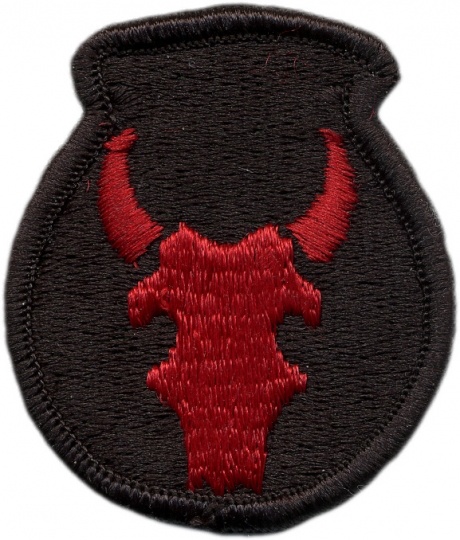
Red Bull Shoulder Patch
A red steer skull on a black Mexican water jar (olla), created in 1917 while the new division trained at Camp Cody, NM, not far from the Mexican border. During World War II, German soldiers in Italy referred to the Americans who wore the patch as "Red Devils" or "Red Bulls." The latter name stuck, and the division adopted it officially, replacing its World War I nickname of "Sandstorm Division."
Public domain
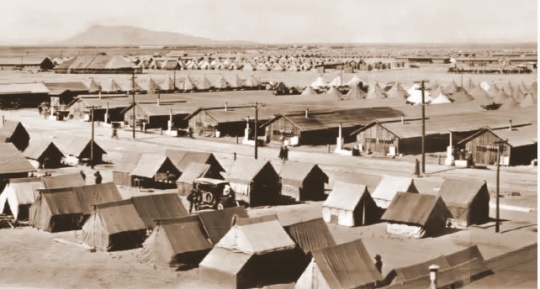
Camp Cody, Deming, New Mexico
Camp Cody, Deming, New Mexico, 1917. Home to the Thirty-fourth Division from August 1917 to August 1918. Image provided by the Minnesota Military Museum.
Public domain
Holding Location
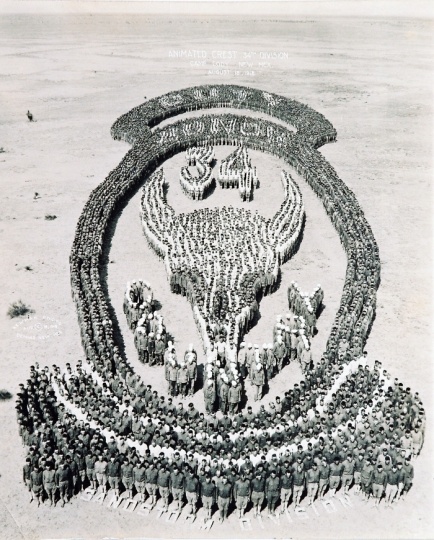
Soldiers at Camp Cody creating animated “Red Bull” Insignia
Thirty-fourth soldiers at Camp Cody, New Mexico, form an “animated” image of their shoulder insignia, just prior to their departure from camp, August 18, 1918. Photograph by Almeron Newman.
Public domain
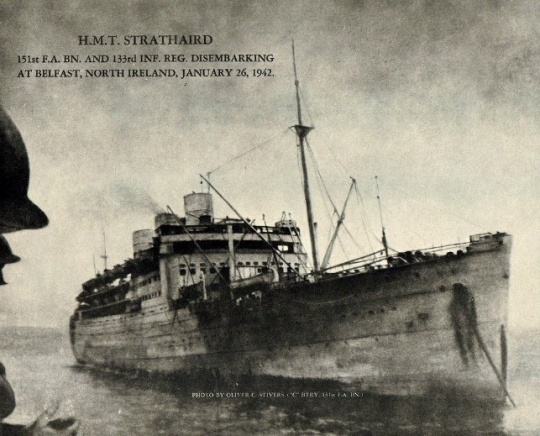
H.M.T. Strathaird
H.M.T. Strathaird, c.1942. The Strathaird transported the initial elements of the Thirty-fourth Division to Northern Ireland in January 1942. The Thirty-fourth was the first US army division to be sent to the European Theater. Photograph by Oliver Stivers of the 151st Field Artillery.
Public domain
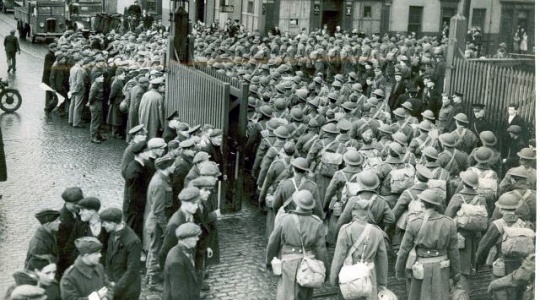
The Thirty-fourth Infantry Division arriving in Belfast, Northern Ireland
The first contingent of Thirty-fourth Infantry Division personnel arriving in Belfast, Northern Ireland, on January 25, 1942. Milburn Henke of Hutchinson, Minnesota, was first off the boat. British papers called him the first Yank to land in Europe. Photograph by the U.S. Army.
Public domain
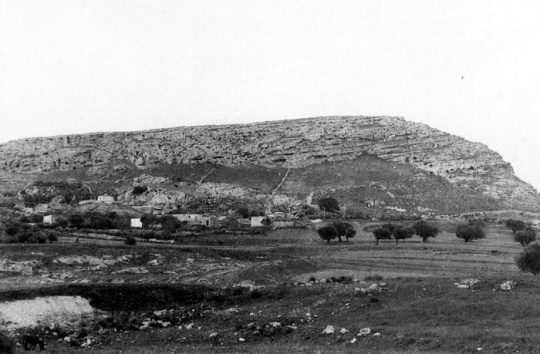
Hill 609 in Tunisia
Hill 609 in Tunisia as soldiers from the Thirty-fourth saw it from the west. Photograph is from the Rick Atkinson Collection.
Holding Location
More Information
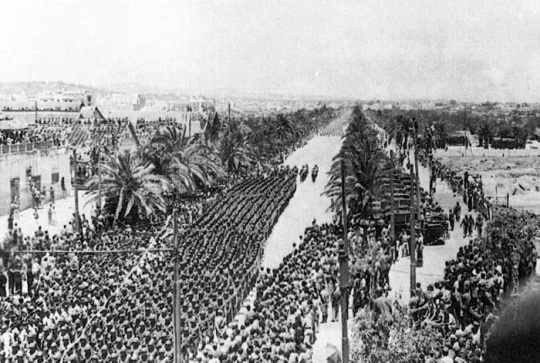
U.S. Soldiers of the Thirty-fourth Division marching through Tunis
American soldiers from the Thirty-fourth Infantry Division march through Tunis in the victory parade on May 20, 1943. Patton complained that “our men do not put up a good show in reviews”; thousands of spectators disagreed, shrieking “Vive l’Amerique” from sidewalks and balconies. Photograph by the U.S. Army.
Public domain
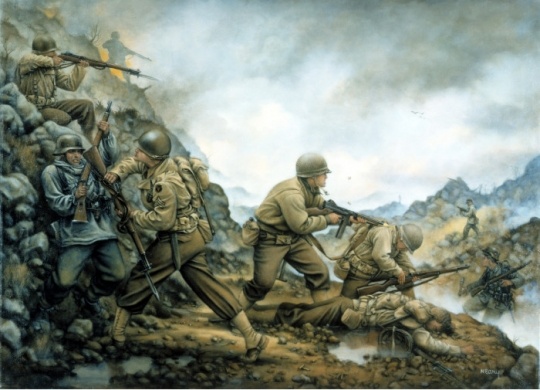
“The Red Bull in the Winter Line”
“The Red Bull in the Winter Line,” painted by by Donna Neary, c.1988. The painting depicts close-in combat by the First Battalion, 168th Infantry, Thirty-fourth Division, during its five-day assault on Mount Pantano, November 1943. The painting forms part of the National Guard’s Heritage Series at the National Guard Bureau.
Public domain
Holding Location
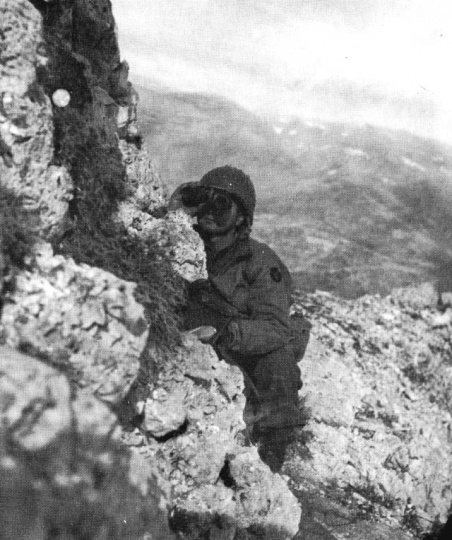
Thirty-fourth Infantry Division officer scans German movements on the approach to Casino
From a mountain perch, a Thirty-fourth Infantry Division officer scans German movements on the approach to Cassino, January 1944. Photograph by the U.S. Army.
Public domain
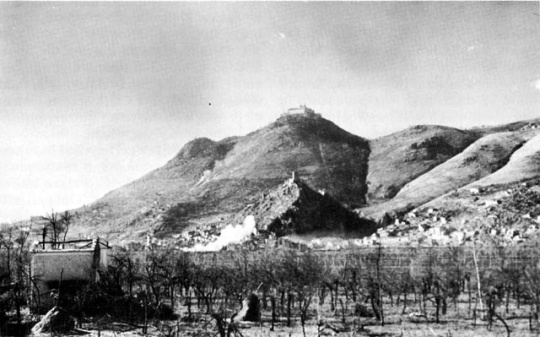
Monte Cassino and the Benedictine Monastery
Monte Cassino and the Benedictine Monastery, commanding a view of the Rapido Valley and the entrance to the Liri Valley, 1943. Attempts to wrest control from the Germans resulted in 80 percent casualty rates for some of the Thirty-fourth Division’s infantry units. Photograph by the U.S. Army.
Public domain
More Information
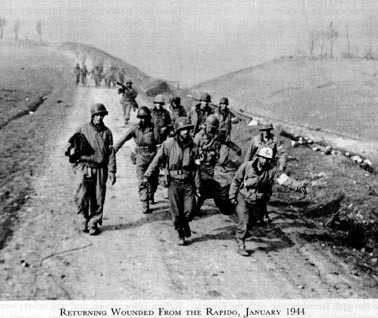
Returning wounded from the Rapido Valley
Returning wounded from the Rapido Valley, 1944. Between Jan. 24 to Feb. 19, 1944, 4795 patients passed through the Thirty-fourth Division’s medical clearing station. Photograph by the U.S. Army
Public domain
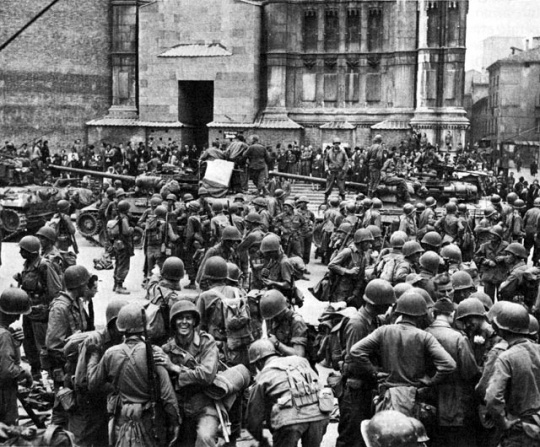
Thirty-fourth Division Infantrymen pause to celebrate the taking of Bologna
Thirty-fourth Division Infantrymen pause to celebrate the taking of Bologna, April 1945. Photograph by the U.S Army.
Public domain
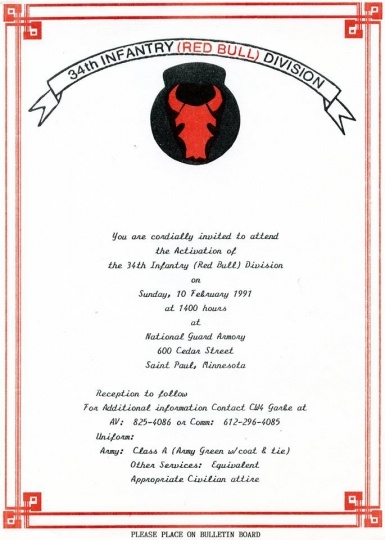
Invitation to Thirty-Fourth Division Reactivation Ceremony
Invitation to the ceremony on February 10, 1991, that reactivated the Thirty-fourth Division. The Forty-seventh “Viking” Infantry Division was redesignated as the Thirty-fourth “Red Bull” Infantry Division—exactly 50 years after the Thirty-fourth was activated for what became World War II. The personnel and organizational structure remained the same; only the name and number was changed. Original invitation held by the Minnesota Military Museum.
Holding Location
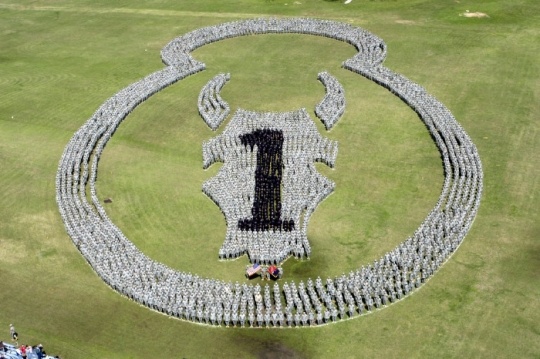
“Animated” Red Bull emblem
Four thousand members of the division’s First Brigade Combat Team create a new “animated” Red Bull emblem at Camp Shelby, Mississippi, just prior to departure for Iraq, March 2006. Photograph by the U.S. Army.
Public domain
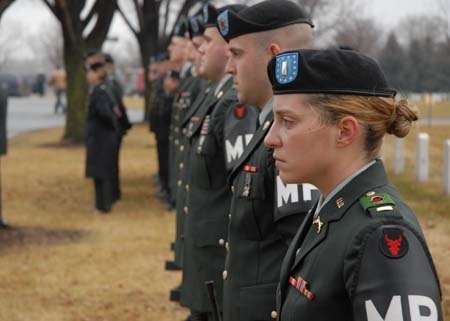
Red Bull firing squad
A Red Bull firing squad honors one of its own at Fort Snelling National Cemetery, December 2006. The Minnesota Thirty-fourth Division soldier was killed by an IED (improvised explosive device) in Fallujah, Iraq. Photograph by Joe Roos of the Minnesota National Guard.
Public domain
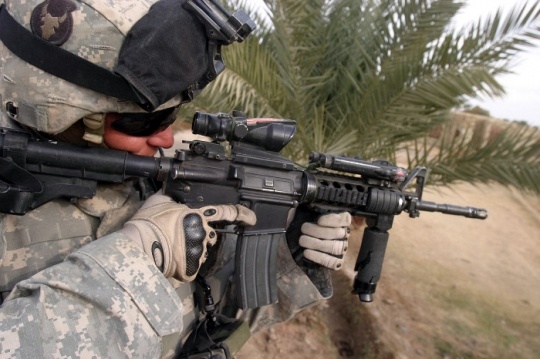
“Red Bull” in Al Naumyah, Al Anbar province, Iraq
A soldier in Bravo Co., Second Battalion, 136 Infantry Regiment (2-136) surveys the area in Al Naumyah, Al Anbar province, Iraq during operation Sledgehammer, December 2006. Photograph by the Minnesota National Guard.
Public domain
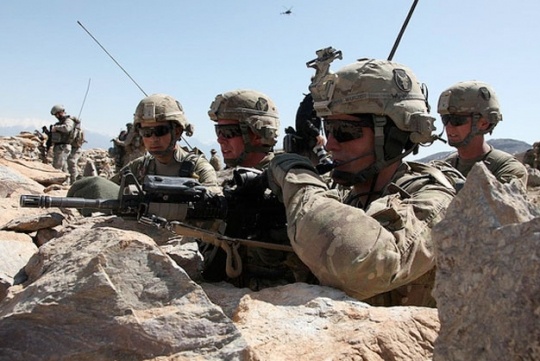
Soldiers from Thirty-fourth Infantry Division in Afghanistan
Soldiers from Thirty-fourth Infantry Division, Task Force Red Bulls, discuss plans to maneuver into Pacha Khak village, Afghanistan, while conducting a dismounted patrol, April 7, 2011. Photograph by the U.S. Army.
Public domain
More Information

A soldier of Second Battalion, 135th Infantry, Thirty-fourth Division
A soldier of Second Battalion, 135th Infantry, Thirty-fourth Division, hugs his wife and son upon returning home from a nine-month deployment to Kosovo, July 2008. Photograph by the Minnesota National Guard.
Public domain
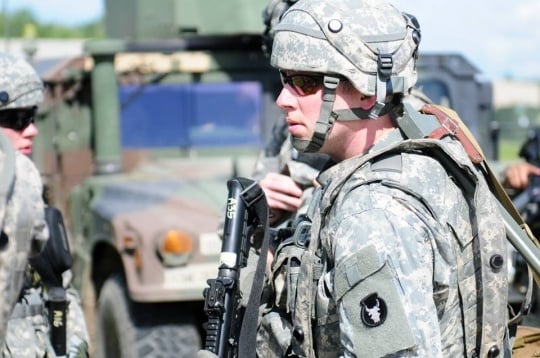
Combat training exercise at Camp Ripley
Combat training exercise at Camp Ripley, June 2015. Photograph by the Minnesota National Guard.
Public domain
More Information
Related Articles
Turning Point
On February 10, 1941, the Thirty-fourth Infantry Division is activated for what eventually becomes World War II.
Chronology
1917
1923
1941
1945
1946
1963
1968
1991
2006
Bibliography
Blumenson, Martin. “Salerno to Cassino.” In U.S. Army in World War II: The Mediterranean Theater of Operations. Edited by Maurice Matloff. Washington DC: Deptartment of the Army. Government Printing Office, 1969.
http://history.army.mil/html/books/006/6-3-1/CMH_Pub_6-3-1.pdf
Fisher, Ernest F. Jr. “Cassino to the Alps.” In U.S. Army in World War II: The Mediterranean Theater of Operations. Washington D.C.: Department of the Army, Government Printing Office, 1977.
http://www.history.army.mil/html/books/006/6-4-1/CMH_Pub_6-4-1.pdf
Holbrook, Franklin F. and Appel, Livia. Minnesota in the War with Germany. Vol. 1. St. Paul: Minnesota Historical Society, 1928.
Hougen, John H. History of the Famous 34th Infantry Division. San Angelo, TX: Newsfoto Publishing Co., 1949. Reprinted by Nashville: Battery Press, 1986.
Howe, George F. “Northwest Africa: Seizing the Initiative in the West.” In U.S. Army in World War II: Mediterranean Theater of Operations. Edited by Maurice Matloff. Washington DC: Department of the Army, Government Printing Office, 1957.
http://www.history.army.mil/html/books/006/6-1-1/CMH_Pub_6-1-1.pdf
Johnson, Jack K. “History of the 34th ‘Red Bull’ Infantry Division.” Minnesota Military Museum, November, 2015.
http://www.mnmilitarymuseum.org/files/2614/4683/6219/34th_ID_history_1917-2015.pdf
Kunz, Virginia Brainard. Muskets to Missiles: A Military History of Minnesota. St. Paul: Minnesota Statehood Centennial Commission, 1958.
MacDonald, Charles B. “Ch. 22 - World War II: The War Against Germany and Italy.” In Army Historical Series: American Military History, 473–483. Washington DC: Government Printing Office, 1989.
http://www.history.army.mil/books/amh/AMH-22.htm
Minnesota National Guard. History of the 34th Infantry Division.
https://minnesotanationalguard.ng.mil/documents/2018/10/34th-infantry-division-artillery-history.pdf
U.S. Army Center of Military History. Lineage and Honors – Headquarters 34th Infantry Division (Red Bull).
http://www.history.army.mil/html/forcestruc/lineages/branches/div/034id.htm
Related Resources
Secondary
Anderson, Charles R. Algeria-French Morocco: The U.S. Army Campaigns of World War II. Washington, DC: Defense Department, U.S. Army Center of Military History, 1972.
http://www.history.army.mil/html/books/072/72-11/CMH_Pub_72-11.pdf
——— . Tunisia: The U.S. Army Campaigns of World War II. Washington, DC: Defense Department., U.S. Army Center of Military History, 1972. http://www.history.army.mil/catalog/pubs/72/72-12.html
Ankrum, Homer R. Dogfaces Who Smiled Through Tears. Lake Mills, IA: Graphic Publishing Co., 1987.
Ashcroft, Howard D. As You Were: Cannon Company. Parsons, WV: McClain Printing, 1990.
Blumenson, Martin. “Kasserine Pass 30 January-22 February 1943,” in America’s First Battles, 226–265. Edited by Charles E. Heller. Lawrence, KS: University of Kansas Press, 1986.
http://www.history.army.mil/books/Staff-Rides/kasserine/Vol-I-Part_1.pdf
Laurie, Clayton. Anzio: The U.S. Army Campaigns of World War II. Washington, DC: Defense Dept., U.S. Army Center of Military History, 1972. http://www.history.army.mil/catalog/pubs/72/72-19.html
——— . Rome-Arno: The U.S. Army Campaigns of World War II. Washington, DC: Defense Department, U.S. Army Center of Military History, 1972.
http://www.history.army.mil/catalog/pubs/72/72-20.html
Oland, Dwight D. North Apennines: The U.S. Army Campaigns of World War II. Washington, DC: Defense Department, U.S. Army Center of Military History, 1972.
http://www.history.army.mil/catalog/pubs/72/72-34.html
Popa, Thomas A. Po Valley: The U.S. Army Campaigns of World War II. Washington, DC: Defense Department, U.S. Army Center of Military History, 1972.
http://www.history.army.mil/catalog/pubs/72/72-33.html
Rush, Robert S. U.S. Infantryman in World War II (#2): Mediterranean Theater of Operations 1942–1945. Oxford, UK: Osprey Publishing, 2002.
Schaps, Ralph B. 500 Days of Front Line Combat: The WWII Memoir of Ralph B. Schaps. Edited by Theresa M. Deane and Joseph E. Schaps. Bloomington, IN: iUniverse Publishers, 2003.
Smith Kenneth V. Naples-Foggia: The U.S. Army Campaigns of World War II. Washington, DC: Defense Department, U.S. Army Center of Military History, 1972.
http://www.history.army.mil/catalog/pubs/72/72-17.html
Vojta, Francis J. The Gopher Gunners: A History of Minnesota’s 151st Field Artillery. Minneapolis, MN: Burgess Publishing, 1995.
Wagner, Bud. And There Shall Be Wars: World War II Diaries and Memoirs. Twig, MN: Wilmer Wagner and Lloyd Wagner Press, 2000.
Wilkinson, Richard F. The Breakthrough Battalion: Battles of Company C of the 133rd Infantry Regiment, Tunisia and Italy, 1943–1945. Saline, MI: McNaughton and Gunn, 2005.
Youngdahl, Herbert M. The Other Side of War. Bandon, OH: Robert D. Reed Publishers, 2000.
U.S. Army Center of Military History. The U.S. Army Campaigns of World War II. Washington, DC: Government Printing Office, 1972.
Websites
34th Infantry Division Association. The Red Bulletin.
http://www.34infdiv.org/
34th Infantry Division Association. The Story of the 34th Infantry Division.
http://www.34infdiv.org/history/34narrhist.html




















